The Tellurium compound, AS101, increases SIRT1 level and activity and prevents type 2 diabetes
- PMID: 22761194
- PMCID: PMC3409680
- DOI: 10.18632/aging.100468
The Tellurium compound, AS101, increases SIRT1 level and activity and prevents type 2 diabetes
Abstract
The histone deacetylase, SIRT1, plays a major role in glucose regulation and lipid metabolism. Ammonium Trichloro (dioxoethylene-o,o') Tellurate, AS101, is a potent in vitro and in vivo immunomodulator, with several potential therapeutic applications. AS101 administration resulted in upregulation of SIRT1 protein expression and activity. These effects were associated with decreased levels of serum insulin like growth factor-1 (IGF-1) and of insulin. The properties of AS101 prompted us to investigate its potential therapeutic role in rats with type 2 diabetes (T2D). T2D was induced by a high fat diet combined with a low dose of Streptozotocin (STZ). Treatment with AS101 before manifestation of hyperglycemia, resulted in increased insulin sensitivity, and decreased blood glucose levels, and prevented symptoms of diabetes including defective glucose clearance, fatty liver, and abnormal distribution of insulin-producing beta cells in the pancreas. Treatment after disease emergence resulted in partial restoration of normal glucose homeostasis. Diabetic rats showed a reduction in liver SIRT1 levels. In both treatment regimens the reduction in SIRT1 levels in the liver were blocked by AS101 consumption. Together, these findings demonstrate the therapeutic potential of AS101 for treating T2D, and for reversing impaired fat and glucose metabolism.
Conflict of interest statement
The authors of this manuscript have no conflict of interest to declare.
Figures
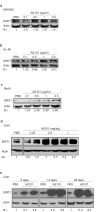
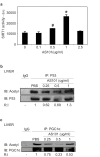
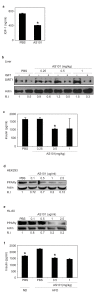
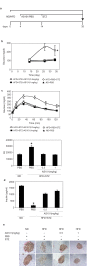
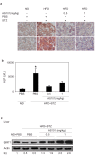
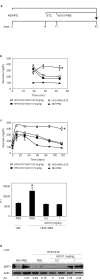
Similar articles
-
The immunomodulatory tellurium compound ammonium trichloro (dioxoethylene-O,O') tellurate reduces anxiety-like behavior and corticosterone levels of submissive mice.Behav Pharmacol. 2017 Sep;28(6):458-465. doi: 10.1097/FBP.0000000000000319. Behav Pharmacol. 2017. PMID: 28590303
-
Differential effect of the immunomodulator AS101 on B7-1 and B7-2 costimulatory molecules: role in the antitumoral effects of AS101.J Immunol. 1996 Jul 15;157(2):589-97. J Immunol. 1996. PMID: 8752906
-
Inhibition of interleukin-10 by the immunomodulator AS101 reduces mesangial cell proliferation in experimental mesangioproliferative glomerulonephritis: association with dephosphorylation of STAT3.J Biol Chem. 2004 Jun 4;279(23):24724-32. doi: 10.1074/jbc.M312006200. Epub 2004 Mar 4. J Biol Chem. 2004. PMID: 15001575
-
The effect of the novel tellurium compound AS101 on autoimmune diseases.Autoimmun Rev. 2014 Dec;13(12):1230-5. doi: 10.1016/j.autrev.2014.08.003. Epub 2014 Aug 19. Autoimmun Rev. 2014. PMID: 25153485 Review.
-
Immunomodulating tellurium compounds as anti-cancer agents.Semin Cancer Biol. 2012 Feb;22(1):60-9. doi: 10.1016/j.semcancer.2011.12.003. Epub 2011 Dec 21. Semin Cancer Biol. 2012. PMID: 22202556 Review.
Cited by
-
Xenohormetic and anti-aging activity of secoiridoid polyphenols present in extra virgin olive oil: a new family of gerosuppressant agents.Cell Cycle. 2013 Feb 15;12(4):555-78. doi: 10.4161/cc.23756. Epub 2013 Jan 31. Cell Cycle. 2013. PMID: 23370395 Free PMC article.
-
Insulin resistance in the liver: deficiency or excess of insulin?Cell Cycle. 2014;13(16):2494-500. doi: 10.4161/15384101.2014.947750. Cell Cycle. 2014. PMID: 25486190 Free PMC article. Review.
-
Cytotoxicity and enzyme inhibition studies of polyoxometalates and their chitosan nanoassemblies.Toxicol Rep. 2014 Jun 6;1:341-352. doi: 10.1016/j.toxrep.2014.06.001. eCollection 2014. Toxicol Rep. 2014. PMID: 28962250 Free PMC article.
-
Novel applications of trophic factors, Wnt and WISP for neuronal repair and regeneration in metabolic disease.Neural Regen Res. 2015 Apr;10(4):518-28. doi: 10.4103/1673-5374.155427. Neural Regen Res. 2015. PMID: 26170801 Free PMC article. Review.
-
Following the Trace of Cyclodextrins on the Selenium and Tellurium Odyssey.Int J Mol Sci. 2024 Jul 16;25(14):7799. doi: 10.3390/ijms25147799. Int J Mol Sci. 2024. PMID: 39063040 Free PMC article. Review.
References
-
- Zierath JR, He L, Guma A, Odegoard Wahlstrom E, Klip A, Wallberg-Henriksson H. Insulin action on glucose transport and plasma membrane GLUT4 content in skeletal muscle from patients with NIDDM. Diabetologia. 1996;39:1180–1189. - PubMed
-
- Kahn CR, Vicent D, Doria A. Genetics of non-insulin-dependent (type-II) diabetes mellitus. Annu Rev Med. 1996;47:509–531. - PubMed
-
- Zimmet P, Alberti KG, Shaw J. Global and societal implications of the diabetes epidemic. Nature. 2001;414:782–787. - PubMed
-
- Saltiel AR. New perspectives into the molecular pathogenesis and treatment of type 2 diabetes. Cell. 2001;104:517–529. - PubMed
Publication types
MeSH terms
Substances
LinkOut - more resources
Full Text Sources
Medical
Miscellaneous

